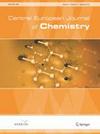Adsorption studies and release of selected dyes from functionalized mesoporous MCM-41 silica
引用次数: 12
Abstract
AbstractFunctionalized mesoporous MCM-41 silica was subjected to adsorption and release studies of encapsulated guest molecules of three chosen dyes. These mesoporous systems were composed of three different capping reagents introduced by grafting method on the silica surface to control the release of dye molecules at two different pH values. The amounts of dyes adsorbed on the silica surface were measured using ultraviolet-visible (UV-VIS) spectrophotometry. The efficiency of grafting was calculated on the basis of differential thermal analysis (TG) results and elemental analysis. The release profiles were determined for all obtained systems using USP Dissolution Apparatus 2. Adsorption of the two azo dyes used was the most efficient after the positively charged functionalization and lower after functionalization with neutral and negatively charged capping reagents, while the phthalocyanine dye adsorption was almost functionalization-independent. Grafting efficiency was the highest for neutral capping reagent and much lower for electrically charged molecules of other reagents. Release studies showed clearly that desorption was pH-dependent for azo dyes and pH independent for Alcian Blue. The adsorption and release seem to be connected with the electrical charge of all constituents of these systems. Results obtained can be used for further analysis of different electrically charged molecules.功能化介孔MCM-41二氧化硅对染料的吸附及释放研究
摘要对功能化介孔二氧化硅MCM-41进行了三种染料包封客体分子的吸附和释放研究。这些介孔体系通过接枝方法在二氧化硅表面引入三种不同的封盖剂来控制染料分子在两种不同pH值下的释放。采用紫外-可见分光光度法测定了二氧化硅表面吸附的染料量。根据差热分析(TG)结果和元素分析计算接枝效率。用USP溶出仪2测定了所有体系的释放曲线。两种偶氮染料在正电荷功能化后的吸附效率最高,而在中性和负电荷封盖剂功能化后的吸附效率较低,而酞菁染料的吸附几乎与功能化无关。接枝效率最高的是中性盖层试剂,接枝效率较低的是其他试剂的带电分子。释放研究清楚地表明,偶氮染料的解吸依赖于pH,而阿利新蓝的解吸不依赖于pH。吸附和释放似乎与这些系统中所有成分的电荷有关。所得结果可用于进一步分析不同的带电分子。
本文章由计算机程序翻译,如有差异,请以英文原文为准。
求助全文
约1分钟内获得全文
求助全文

 求助内容:
求助内容: 应助结果提醒方式:
应助结果提醒方式:


